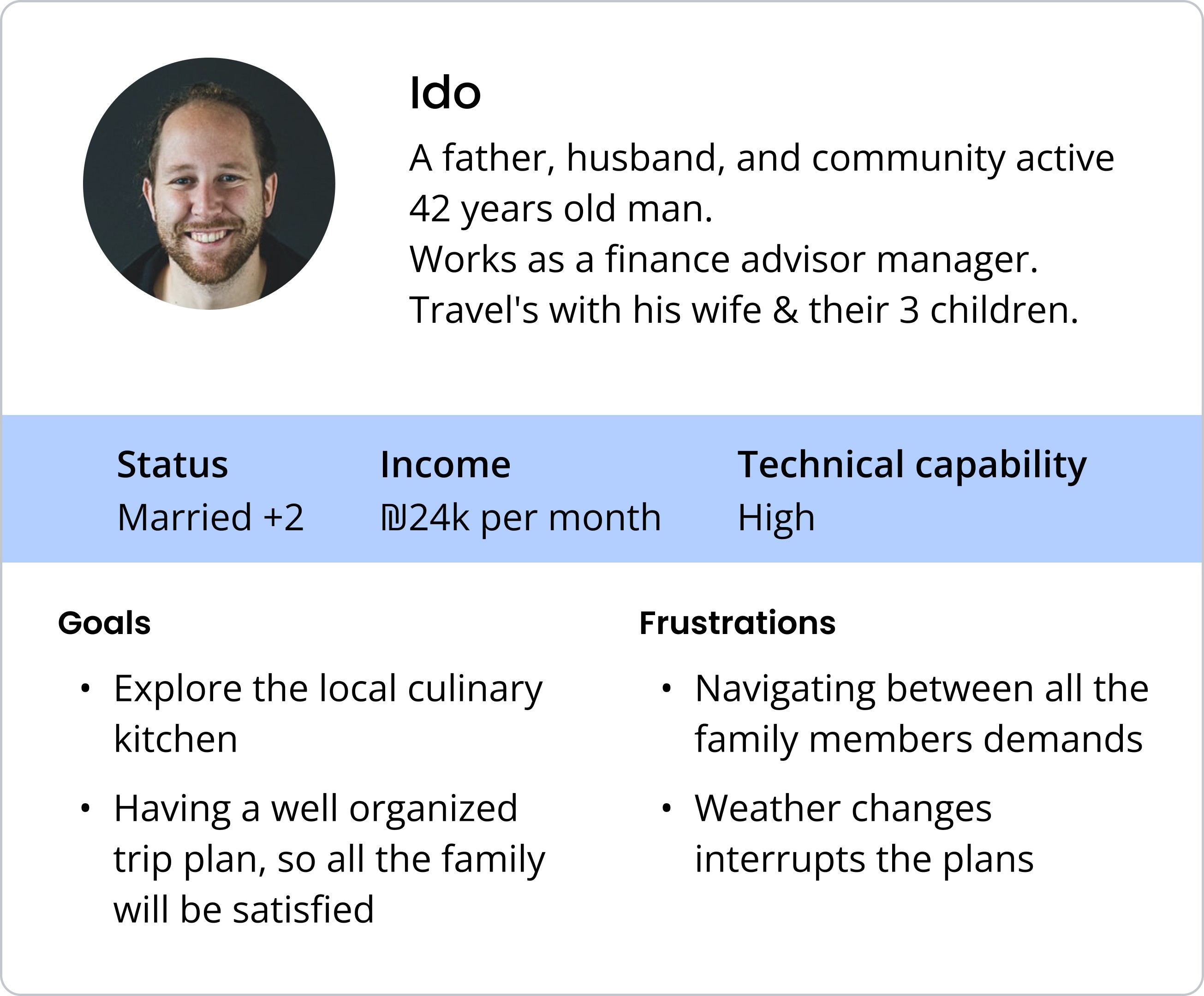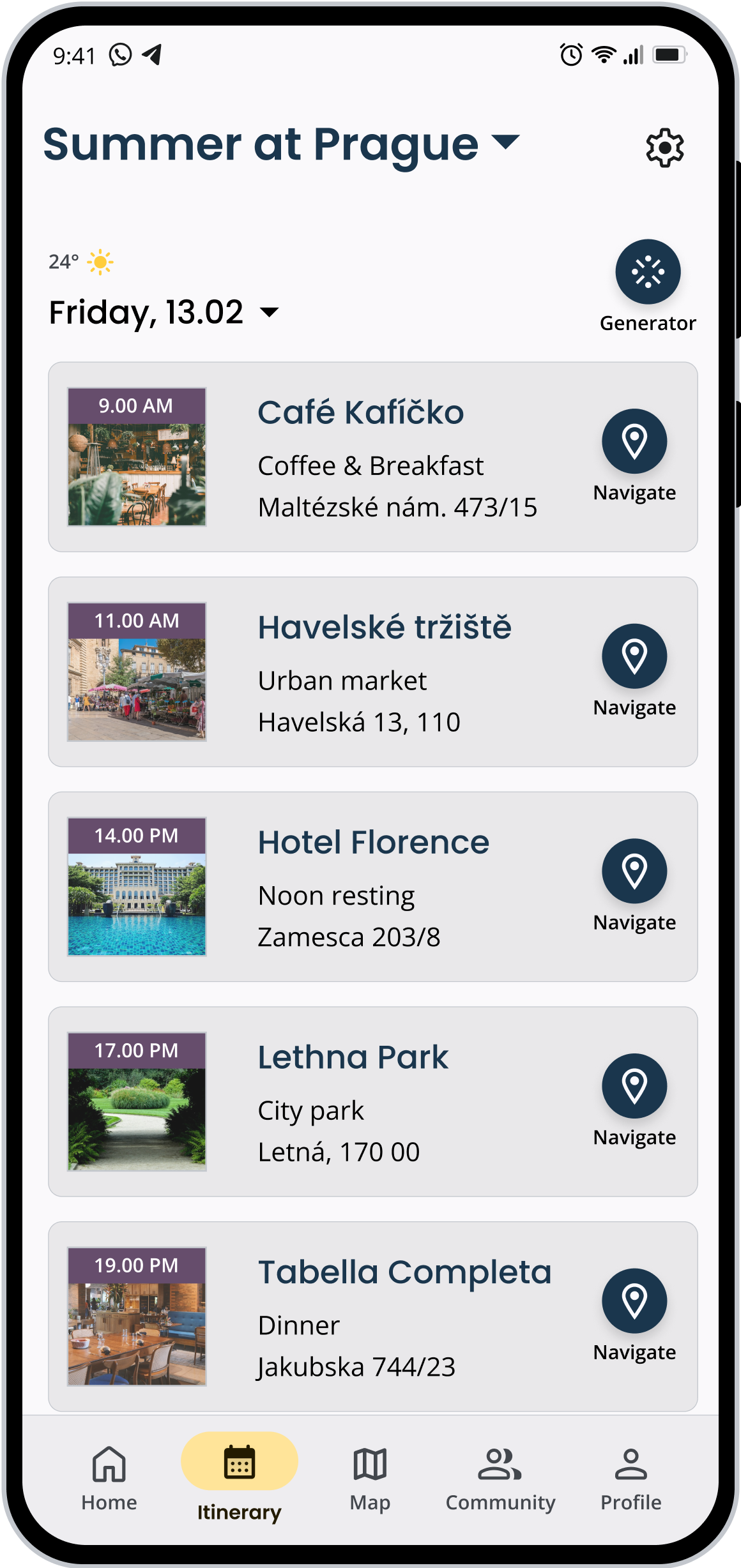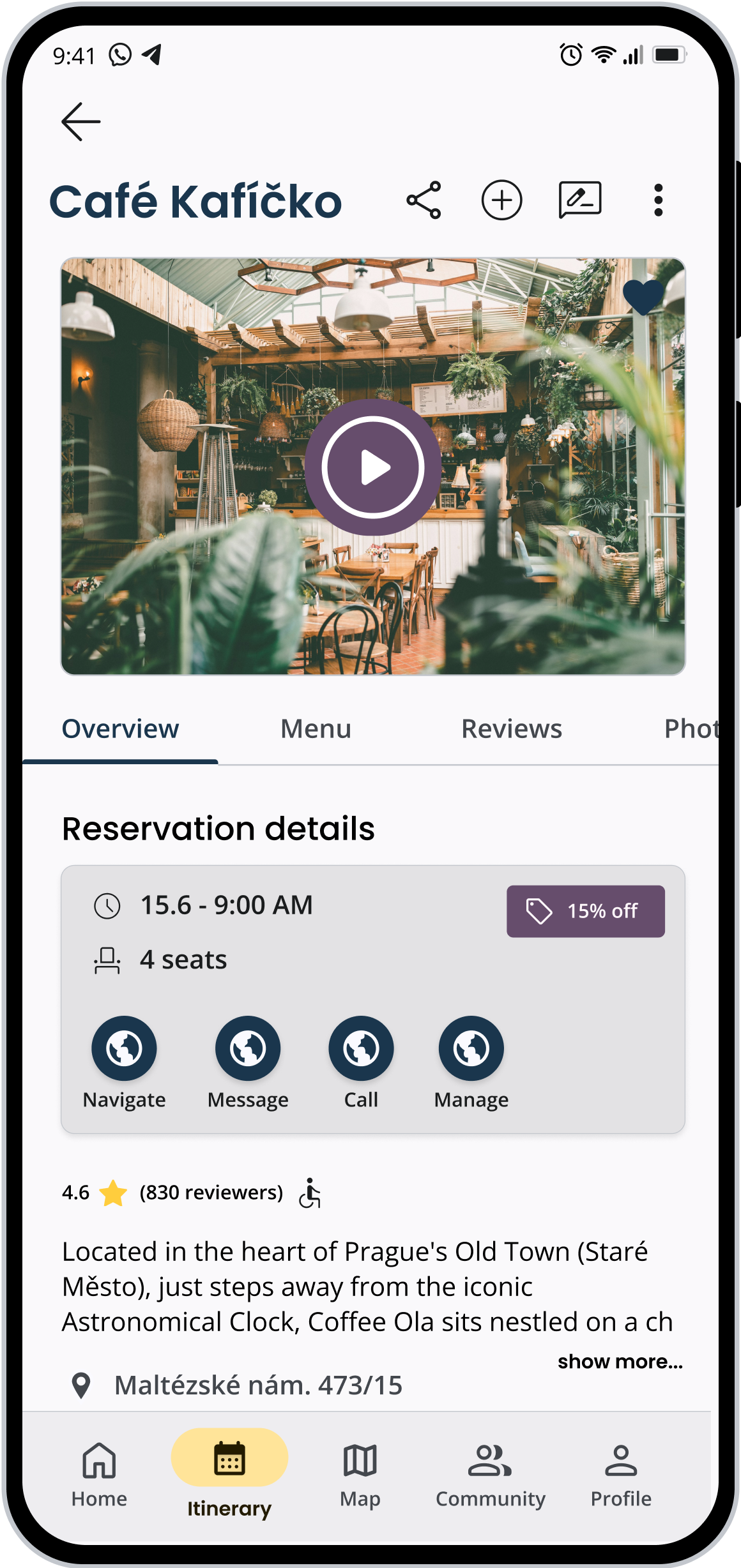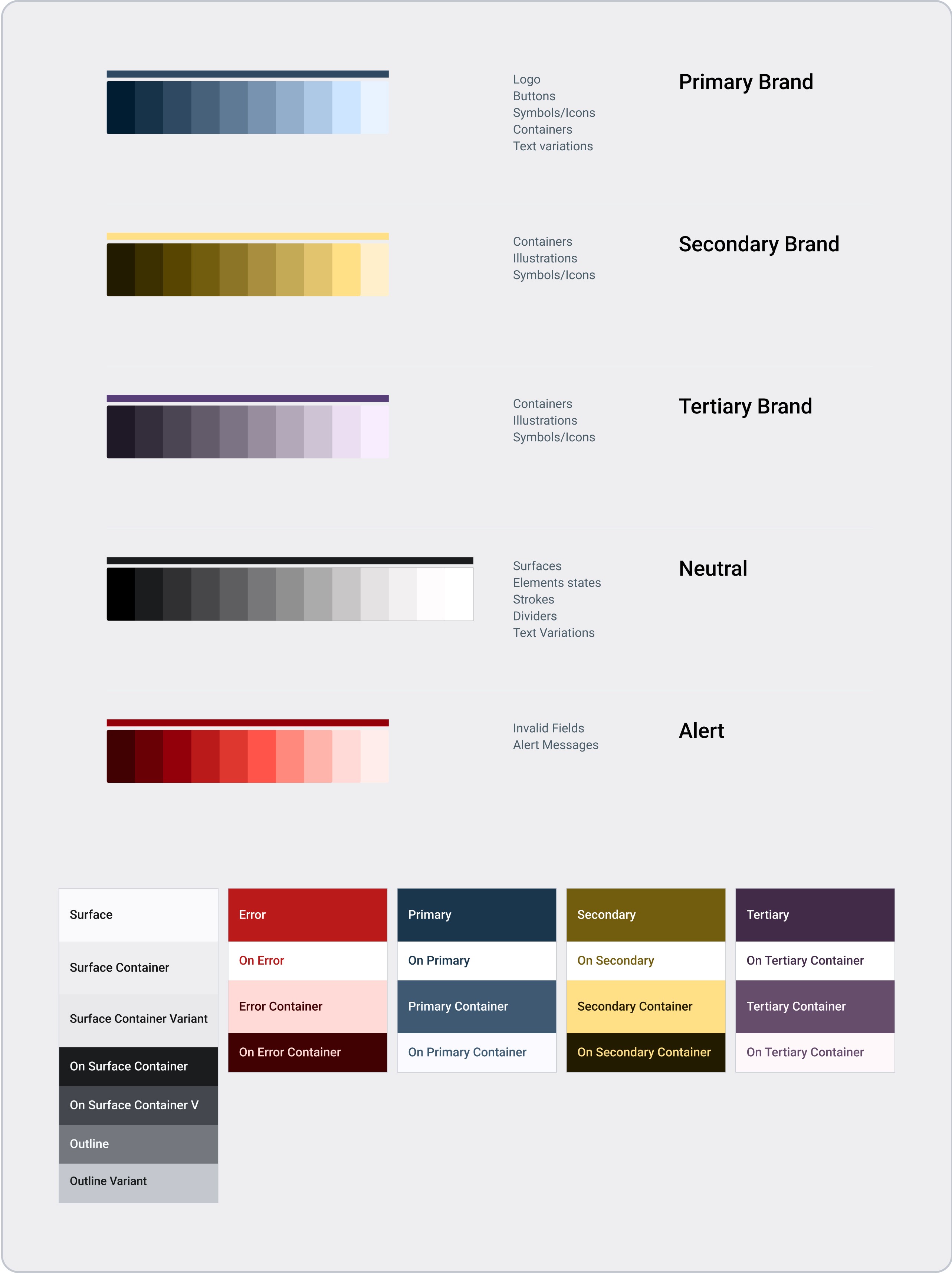UrbanTrail
Urban Tourism App
Explore. Plan. Enjoy.
Your trip, your way!

Product Design
|
UX Research
|
UX-UI Design

Introduction
Through my extensive travels around the world, I learned a great deal about the gaps between travelers’ needs and what existing applications offer. I decided to define and design an application that would enable travelers to gain much more value in planning and executing their journeys.
Given that the target audiences in this domain are virtually endless, I chose to focus on urban travelers from the middle class and above, traveling either solo or in small groups of friends and families.
Research

User research
I started with a user research, using tools such as questionnaire, interviews & collecting data from previous researches.
I sent a survey to approximately 24 participants, whom I reached through dedicated Facebook groups for travelers in European cities. Bellow are the key findings from the research:
General characteristics
- 90% of respondents were between the ages of 29-55, with a nearly balanced gender ratio (a slight male majority).
- The average monthly income of respondents ranged between 5,000-20,000 ILS, with most earning above 10,000 ILS per month.
- 46% of participants were solo travelers, 35% were families with children, and 23% were small groups of friends traveling together.
- Preferred activities were diverse and included restaurants and cafés, nightlife, museums and cultural sites, and shopping.

Travel Preferences
- 90% of participants would use a travel app for trip planning, but most still want control over daily adjustments. Only 10% found it unnecessary.
- 75% preferred using public transportation and walking.
- 25% stated they would rent a car, and 20% said they would use taxis (there may be overlap between these groups).
- Only 2% expressed interest in renting bicycles.
- 75% relied on Google Maps for navigation.
- A smaller percentage mentioned using Waze, physical maps, or asking locals for directions.
- 68% rated their technological proficiency as high, while 29% had a medium-high level of proficiency.
- Only 3% considered their technological skills to be low.

Needs & Frustrations
Planning a trip is a frustrating and time-consuming process, requiring travelers to sift through endless information from blogs, travel groups, and apps. The overwhelming selection makes it difficult to filter options, often leading to compromises.
Many participants expressed a desire to connect with fellow travelers in real time and receive recommendations from locals to discover hidden gems beyond typical tourist spots. Although they were open to using an app for planning and execution, concerns about safety arose, with some users preferring to verify recommendations to avoid unsafe areas.
Personas


Competitors Analysis
The dominant platforms in the market, such as Google Reviews and TripAdvisor, suffer from significant disadvantages.
First, they fail to address the frustrations and needs identified in the research. They lack essential features for trip planning and execution, such as timeline organization and optimal transportation recommendations.
Additionally, these platforms are overloaded with options, making it difficult for users to filter through them effectively. There is no mechanism for personalized attraction discovery, forcing travelers to sift through countless irrelevant suggestions before finding something suitable.

Ideation
Application's Attributes
App Identity
I defined a set of core values to guide the design process: Intuitive, Pleasurable, Vibrant, and Supportive. These values were derived from the general domain of the app (travel) and key insights identified during the research phase.
Core Features
The app will include two primary capabilities:
- A smart trip-planning algorithm that personalizes itineraries based on user preferences and behavior, reducing effort and frustration.
- A real-time trip management system that helps with navigation, time organization, safety, and logistics.
Personalization Process. Users will go through a customization flow (optional) to define their interests, travel habits, and priorities, allowing the algorithm to create a tailored itinerary and optimize execution. The interface will also adapt visually with elements like a customized color palette that reflects user preferences.
Group Travel Planning. The app will support collaborative trip planning, enabling multiple users to coordinate their itinerary with shared editing permissions.
System Design
Typography
The app uses two complementary fonts: Poppins for headings and buttons, and Open Sans for body text, labels, and descriptions.
Poppins is a geometric sans-serif typeface with a clean, monolinear structure. Its support for both the Latin and Devanagari scripts makes it well-suited for an internationally-focused platform. Its rounded terminals enhance intuitiveness and user-friendliness.
Open Sans is a humanist sans-serif typeface that supports Latin and Cyrillic alphabets. It is modern, approachable, and highly readable on screens, making it ideal for the app’s interface.
Color Palette
The primary color, Aegean Blue, was chosen for its association with trust and reliability, reinforcing the app’s values of security and ease of use. The secondary color, a yellow-orange, adds a touch of adventure and energy, creating a balanced yet dynamic contrast with the blue.
Business Model
The app will generate revenue through in-app bookings, partnerships, and sponsored content:
- In-App Bookings & Partnerships – Users can book hotels, activities, transportation, and restaurants directly through the platform, with the app earning a commission on each transaction. Strategic partnerships will provide exclusive deals, benefiting both users and service providers.
- Sponsored Listings & Ads – Businesses such as restaurants, attractions, and tour operators can promote their services through sponsored placements in search results and recommendations. Ads will be targeted and non-intrusive, ensuring a seamless user experience.
This model creates diverse revenue streams while keeping the platform valuable and user-friendly.
Wireframes
Home Page
Upon entering the app, users are presented with several components such as. upcoming activities from their itinerary, system recommendations for nearby attractions, based on their interests and location, and relevant blog posts & travel tips, offering inspiration and useful insights.
This ensures a smooth, engaging experience, keeping users informed and inspired throughout their journey.

Itinerary
On the Itinerary page, users can view their current trip schedule and access past or upcoming trips. The trip generator allows for flexible modifications—users can edit specific details, add or remove activities, and let the system adjust the schedule accordingly.
They can also refine their travel preferences and interests to receive a more tailored itinerary. Additionally, a natural language AI chat enables users to request changes dynamically, allowing for a more intuitive and interactive planning experience.
experience, keeping users informed and inspired throughout their journey.

Community
The community page enables users to connect with travelers, find trip partners, and join events such as pub crawls or group chats. It also offers local meetups, allowing users to join city tours or socialize with locals.
The page features a personalized feed that displays personalized content, while search option is always available for further exploration. Additionally, the chat platform allows users to message fellow travelers, event organizers, bloggers, and participate in various group chats created by users.

Activity page
Each attraction has its own page featuring reviews, media, additional details (such as a menu for culinary places), and external links. The user can share, leave a review, share content and more.
If the user has made a booking through the system, he will see the booking details on the page and will have the option to navigate, modify the booking, or contact the location directly.

Other features
There are many more features in the app that I can’t showcase here due to space limitations, but here are a few highlights:
The app will include a payment system, allowing users to make transactions with various businesses while enjoying exclusive discounts and perks. Additionally, users can track their trip expenses and set a daily budget to manage their spending efficiently.
A Favorites page will store all saved content. Since users will primarily engage with this section during the planning phase, it may not require direct access from the main menu. Instead, it will be accessible via the map and personal profile.
The Blog section will feature traveler blogs, local recommendations, general travel articles, safety tips, and more, offering users valuable insights and inspiration for their journey.
Map
The map view is a key feature of the app, allowing users to navigate, search for attractions and explore their surroundings.
The map adapts to different modes based on user preferences:
- Standard mode: Displays the area, scheduled attractions, and saved content.
- Navigation mode: Guides users to their destination based on their preferred transportation method.
- Itinerary mode: Shows a route connecting upcoming attractions according to the planned schedule.
Personalization process
The personalization process allows users to tailor their trip based on their preferences and travel habits. Users start by selecting their interests from a gallery of relevant activities, followed by defining their preferred modes of transportation, such as walking, public transport, taxis, bikes, rental cars, or ridesharing. They can also specify how far they are willing to travel from their accommodation and set a daily ‘on road’ limit.
The itinerary is further customized with daily scheduling preferences, including start times, meal breaks, and the desired balance between a packed, balanced, or relaxed schedule. Users can establish a budget, either as an overall amount or categorized by expenses, with the option to define individual or group spending limits.
Additionally, they can set automatic schedule adjustment rules, allowing the app to suggest changes in response to factors like weather or delays—though all modifications require user approval. The platform supports both individual and group planning, helping multiple travelers align their preferences for a well-balanced itinerary.
All rights reserved to Yotam Malkiel, TLV, 2022
Some of the graphic elements in this project were taken from Freepik



